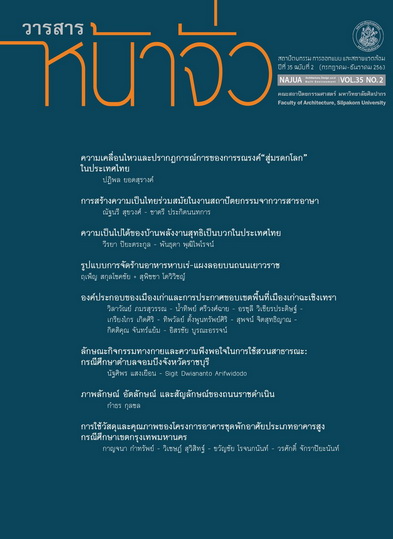รูปแบบการจัดร้านอาหารหาบเร่-แผงลอยบนถนนเยาวราช
คำสำคัญ:
ย่านเยาวราช, ย่านคนจีนของเมือง, อาหารข้างทาง, ผู้ค้าขายริมถนนบทคัดย่อ
วิจัยนี้มุ่งศึกษาสภาพแวดล้อมทางกายภาพของร้านอาหารหาบเร่-แผงลอยบนถนนเยาวราช ช่วงตั้งแต่แยกทรงสวัสดิ์ ถึงแยกมหาจักร เพื่อทำความเข้าใจลักษณะทางวัฒนธรรม รูปแบบและพฤติกรรมการใช้งานการจัดสภาพแวดล้อม ร้านอาหารหาบเร่-แผงลอย โดยมีขอบเขตในการเลือกกลุ่มตัวอย่าง เป็นร้านอาหารหาบเร่-แผงลอยที่มีพื้นที่นั่งรับประทานอาหาร และไม่ได้ตั้งอยู่ในซอยหรือมีตัวร้านเชื่อมในถนนที่ตัดผ่านกับพื้นที่ศึกษา มีกลุ่มตัวอย่างจำนวนทั้งหมด 36 ร้านค้า โดยใช้วิธีการสำรวจ สังเกต พร้อมทั้งสเก็ตรูปแบบการจัดร้าน การวางผัง และบันทึกพฤติกรรมการใช้งาน นำผลที่ได้มาบันทึกข้อมูล ใส่ตารางแยกตามประเภทของพฤติกรรมการใช้พื้นที่และการประกอบอาหาร
จากการสำรวจสามารถจัดกลุ่มและแบ่งประเภทของร้านขายอาหารหาบเร่-แผงลอยบนพื้นที่ศึกษา โดยแบ่งออกเป็น 1) การใช้พื้นที่ทำอาหารแยกแต่ละร้าน 2) การใช้พื้นที่ทานอาหารร่วมกัน และจากลักษณะการใช้พื้นที่ดังกล่าว สามารถแบ่งออกได้เป็น ประเภทตามการประกอบอาหาร แบ่งกลุ่มได้เป็น 10 ประเภท ประเภทที่ 1 ขนมหวาน ประเภทที่ 2 น้ำดื่ม ประเภทที่ 3 ขนมผลไม้ ประเภทที่ 4 ก๋วยเตี๋ยว ประเภทที่ 5 อาหารทะเล ประเภทที่ 6 ก๋วยจั๊บ ประเภทที่ 7 หูฉลาม กระเพาะปลา ผัดหมี่ คั่วไก่ ประเภทที่ 8 อาหารจานด่วน ประเภทที่ 9 อาหารอีสาน และ ประเภทที่ 10 ร้านอาหารที่ใช้พื้นที่ร่วมกัน โดยการจัดแบ่งพื้นที่ภายในร้านอาหารหาบเร่-แผงลอย สามารถแบ่งพื้นที่ใช้งานออกเป็น 4 ส่วน คือ พื้นที่ปรุงอาหาร พื้นที่นั่งทานอาหาร พื้นที่บริการน้ำดื่ม และพื้นที่ล้าง
จากข้อมูลการศึกษา พบว่าความต้องการในการใช้งานและลักษณะพฤติกรรมการทำร้านอาหารหาบเร่-แผงลอย ที่เป็นอาหารจีน มีอุปกรณ์ที่ความจำเป็นต่อขนาดของพื้นที่ใช้งานคือ รถเข็นแบบสำเร็จรูป และโต๊ะเก้าอี้ สำเร็จรูป โดยในส่วนของรถเข็นนั้น ร้านที่ทำอาหารแบบจีนมีข้อสังเกตที่น่าสนใจ คือกลุ่มร้านอาหารประเภทก๋วยเตี๋ยว ใช้พื้นที่ปรุงอาหาร ร้านก๋วยเตี๋ยวเย็นตาโฟ มีขนาดพื้นที่ปรุงอาหาร ใกล้เคียงกับขนาดรถเข็นสำเร็จรูป (เนื่องจากออกแบบมาเพื่อการติดตั้งหม้อก๋วยเตี๋ยว) แต่เมื่อเป็นร้านอาหารจีน ประเภท ผัด พื้นที่ในการปรุงอาหารมีขนาดใหญ่ เนื่องจากต้องการพื้นที่ที่มีลักษณะเฉพาะของการใช้อุปกรณ์ เช่น กระทะจีน มีความต้องการพื้นที่เพื่อการปรุงอาหารด้วยไฟแรง จึงต่อเติมพื้นที่จากรถเข็นพื้นฐาน จึงเกิดวิธีการในการแก้ปัญหาด้วยการเพิ่มอุปกรณ์ต่าง ๆ ขยายพื้นที่การใช้งานบนฟุตบาทมากขึ้น เนื่องด้วยรถเข็นอาหารไม่สามารถตอบสนองพฤติกรรมการทำอาหารแบบจีนได้อย่างครบถ้วน
เอกสารอ้างอิง
- Nirathron, N. (2006). Fighting poverty from the street: a survey of street food vendors in Bangkok. Bangkok: ILO.
- Pimonsathean, Y. (2009). Arkan Tee Mee Kun Ka Kuan Gae Gan Anurak Borriwayn Tanon Jarern Grung Dton Bon. (in Thai) [Heritage Buildings on Northern Chareon Krung Road]. Bangkok: Icomosthai.
- Thansettakij Connecting Opportunity. “Yaowarat is happy, delicious, safe”. The Ministry of Tourism invites you to taste street food. Retrieved May 24, 2017, from http://www.thansettakij.com/content/153957.
- Wongcharean, T. (2012). Roop Baep Gaan Jat Raan Guay-Dtieow Hap Ray Paeng Loi. (in Thai) [The Physical Pattern of Street Vendors ’Noodle Shop]. Master of Architecture, King Mongkut’s Institute of Technology Ladkrabang.





